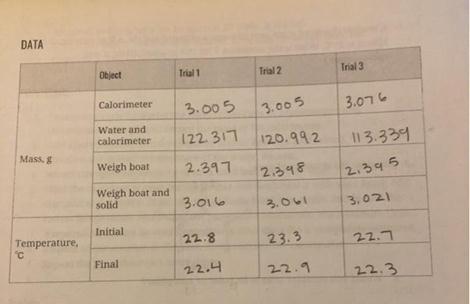1. Calculate the heat of solution (qrxn) for each trial. Find qsoln first. The heat of the dissolution (qsoln) is calculated using the formula q = -cmΔT where c is the heat capacity (approximated by the heat capacity of water as 4.184 Jg-1℃-1), m is the mass of the solution, and ΔT is the temperature change. The heat capacity of the calorimeter will not be included in the calculation.
2. Calculate the ΔH for each trial in kJ/mol using the heat of solution (qrxn) and the moles of the solid.
3. Τhe molar enthalpy change is just the heat of dissolution over n, the number of moles solid, or ΔH = q / n. Since the temperature decreases, the reaction is endothermic and ΔHo should be positive.
4. Average the ΔHs for your trials.
5. Calculation of ΔGo: Look up the value of Keq for the solid used (The equilibrium constant, Keq, is simply the number of moles of urea used to make a saturated solution divided by the total volume in L). The free energy change of the dissolution is calculated using the formula ΔGo= -RTlnKeq where R is the gas constant (8.31451 J K-1mol-1) and T is the temperature in Kelvin.
The molar mass of urea is 60.06 grams per mol

Students succeed in their courses by connecting and communicating with an expert until they receive help on their questions

Consult our trusted tutors.